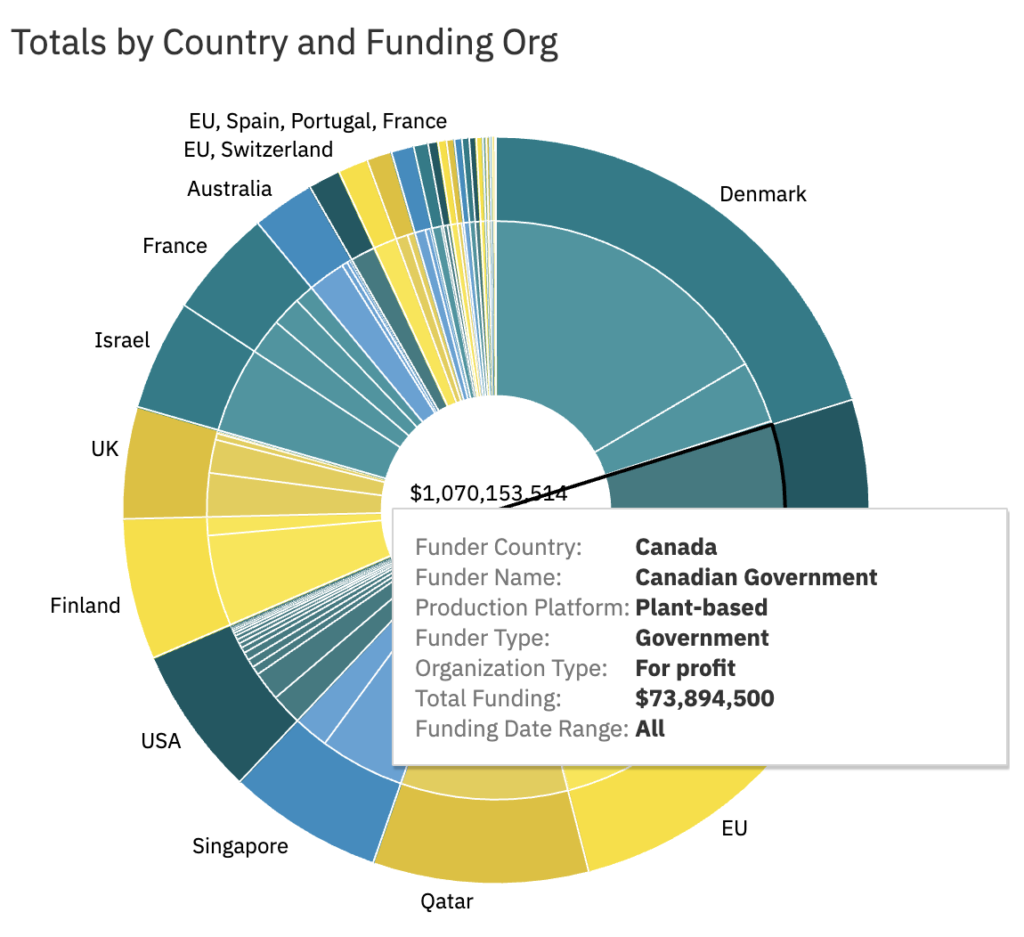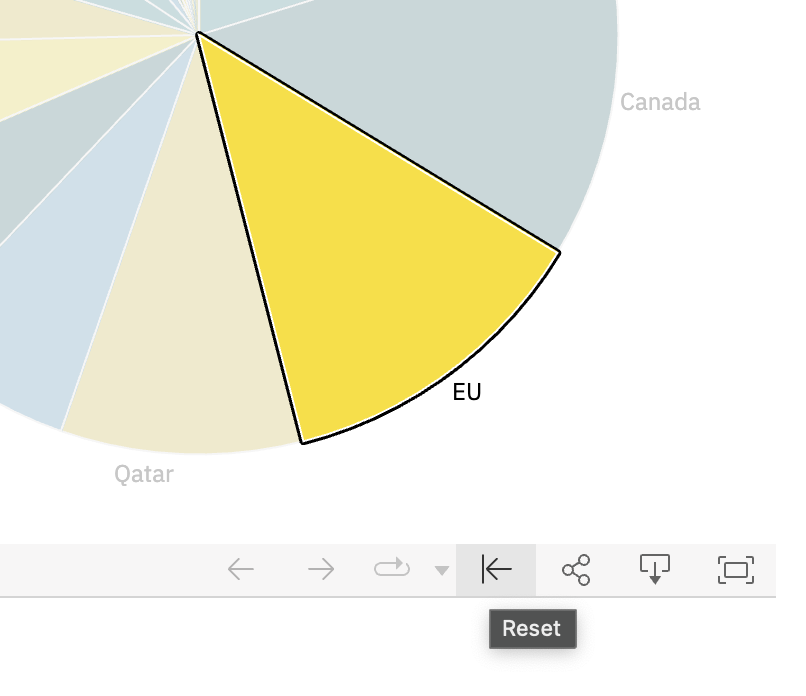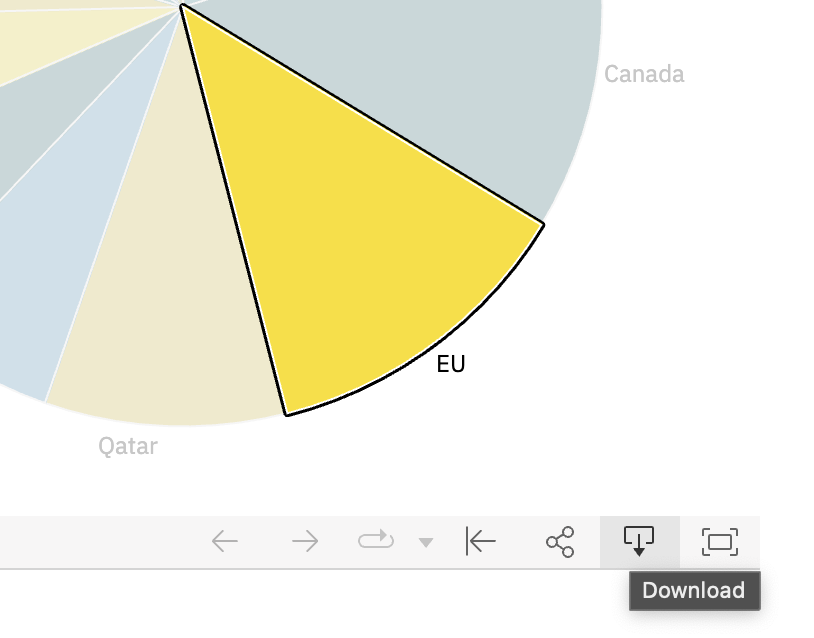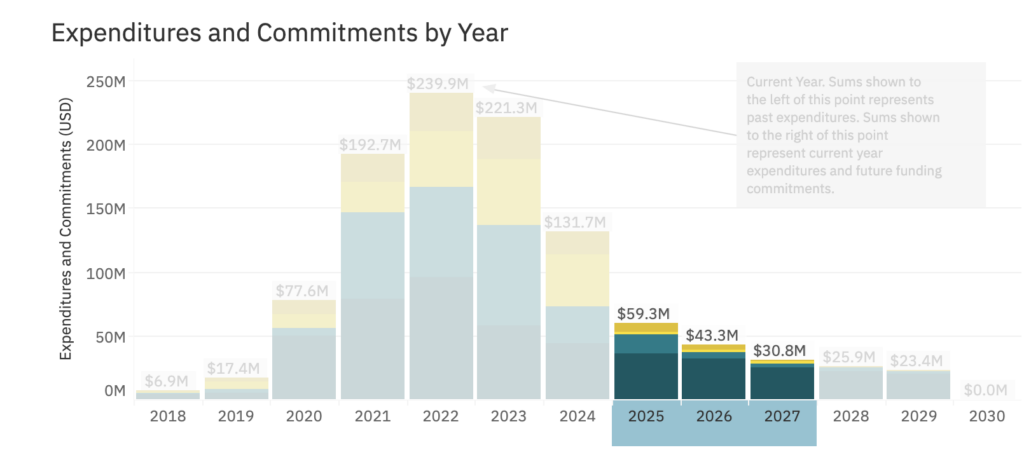Alternative protein research grants dashboard and tracker
Explore our global alternative protein research grants dashboard and tracker database to discover insights about open-access research, including what’s being funded, who is funding it, at what levels, and more.

Explore the research grants dashboard
Find high-level trends for grants awarded in alternative protein research
Discover overall research trends across alternative protein technology pillars
Our alternative protein research dashboard aggregates publicly available information about non-dilutive alternative protein research funding. Our dashboard allows you to:
- Filter year-by-year funding support in each research pillar.
- Refine results based on the types of organizations funding the research and the organizations receiving the funding.
- View a worldwide map and chart of alternative protein funding.
- Filter the map and chart by total, to-date, and future commitments.
The best part is that all graph, map, and chart views produced on the dashboard are downloadable into formats that include jpeg and PDFs for pasting into your documents or presentations.
Dig deeper to understand the current funding landscape
Our alternative protein research grants tracker compiles details on publicly available information about non-dilutive alternative protein research funding. The database focuses on grants with technical aims such as improvements in sensory characteristics or building facilities that will better enable scale-up of technology. Our tracker does not include consumer or market research, nor does it include venture capital or private equity investments (that information can be found in our State of the Industry reports).
With our grants tracker, you can see who is funding alternative protein research (governments vs. industry, including breakdowns by country), how much money has been awarded, whether those funds were awarded to industry or academia, if the results will be made public, and more. Use the filter function to slice the data however you see fit to better understand the current state of alternative protein research funding.
Crowdsourcing answers
This database is regularly updated, but we encourage crowdsourced contributions to ensure that it is as accurate and comprehensive as possible. If you know of any alternative protein grants missing from this database, please share them with us.
"*" indicates required fields
The scale and urgency of the challenge
Paradigm-shifting technologies, capable of solving some of the world’s most pressing challenges, require substantial amounts of research. From 1976 to 2016, global funding for renewable energy research and development averaged $10-22 billion (in 2016 USD) every year1, amounting to $600 billion over four decades. In contrast, grants from 2005 to-date for alternative protein research since 2005 total a mere $757 million—about one-thousandth of total R&D expenditures for renewable energy. Given that almost one-fifth of global greenhouse gas emissions come from animal agriculture and associated land use, it’s clear that increased R&D in alternative proteins can equip the world with scalable solutions to tackle climate and other global challenges2.
In order to accelerate the shift toward a sustainable, secure, and just protein supply, vastly more investment into alternative protein research is required. The fruits of these investments are clear: by 2018, due in large part to the massive R&D investment the field had received for at least a half-century, renewable energy comprised 26.2 percent of global energy production3. By contrast, retail plant-based meat sales currently account for only 1.4 percent of total retail meat sales4. Commensurate investment into research and development is needed now to achieve improvements in sensory traits, cost reduction, and scalability to enable alternative proteins to reach mainstream adoption.

Want more details about expert alternative protein researchers?
The alternative protein researcher directory is our global database of researchers working on projects related to plant-based, cultivated, and/or fermentation technologies.
FAQs
Is there a method to find more information without changing the view?
Tooltips! Hover over the area of the dashboard you would like more information about and that information will pop up.

How do I reset the dashboard?
In the bottom right-hand corner of the dashboard, there is a reset button. Press to reset back to starting conditions.

How do I download the data or images?
Pin the bottom right-hand corner of the dashboard, there is a download button. This gives you multiple options for downloading (including pdf which will be the highest-quality image).

How do I focus on a specific time range?
Holding down the shift key and clicking on the years along the x-axis of the bar graph will highlight those years and gray out the others.

Meet the authors

Erin Rees Clayton, Ph.D.
SCIENTIFIC RESEARCH ADVISOR
Erin tracks new research developments and articulates high-impact priorities in need of funding by key stakeholders.

Patrick Landy
SOFTWARE ENGINEER
Patrick creates engaging visualizations of GFI data using tools such as Tableau.

Vanessa Assaro-Aluisa
SCIENCE AND TECHNOLOGY COORDINATOR
Vanessa connects data between our database and visualization dashboards as well as coordinates the creation and maintenance of the research tracker dashboard and database’s web presence.

Matt Hotze
DIRECTOR OF SCIENCE AND TECHNOLOGY
Matt leads the dashboard development team.
Check out our related resources

Advancing solutions for alternative proteins
Explore commercial whitespaces, research gaps, technological needs, and investment priorities at each stage of the alternative protein value chain.

Alt proteins can transform our food system–tracking research grants can keep us on target
Research can propel alternative protein innovation and accelerate the shift to a more sustainable food system. Mapping the funding landscape can reveal critical opportunities to bolster innovation.

Research funding database
GFI’s research funding database provides curated grant opportunities for open-access alternative protein research.

Securing government funding
Government support will accelerate the growth of alternative proteins. Learn how GFI works to secure public funds for alternative protein research.
*Stats at top of page last updated May 1, 2023
